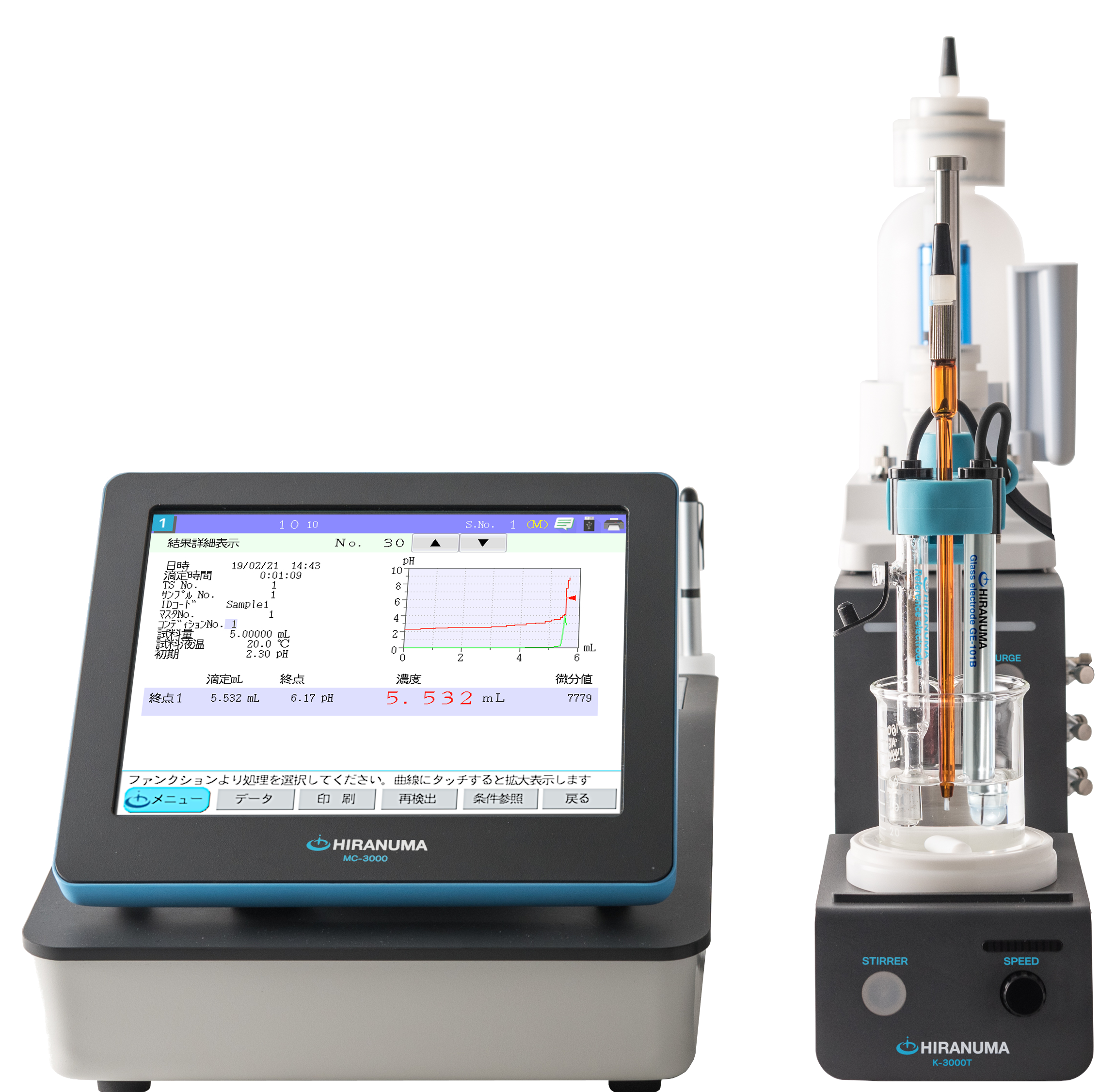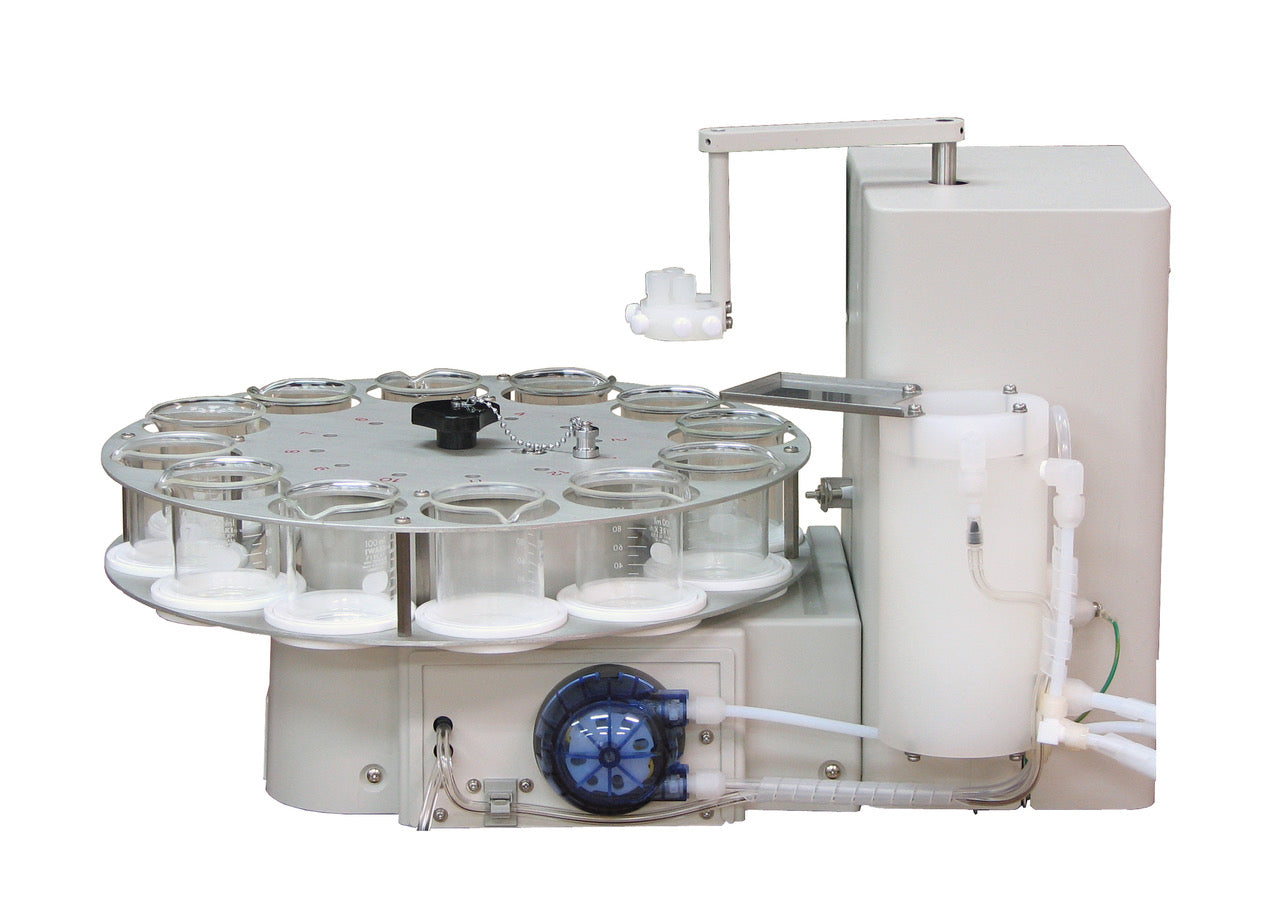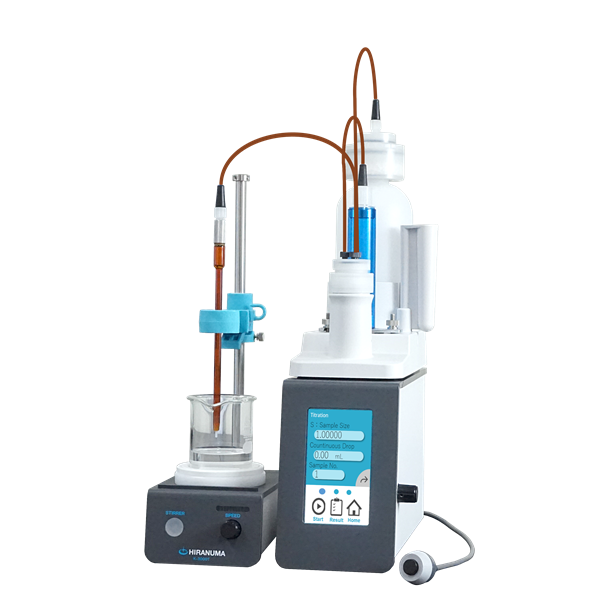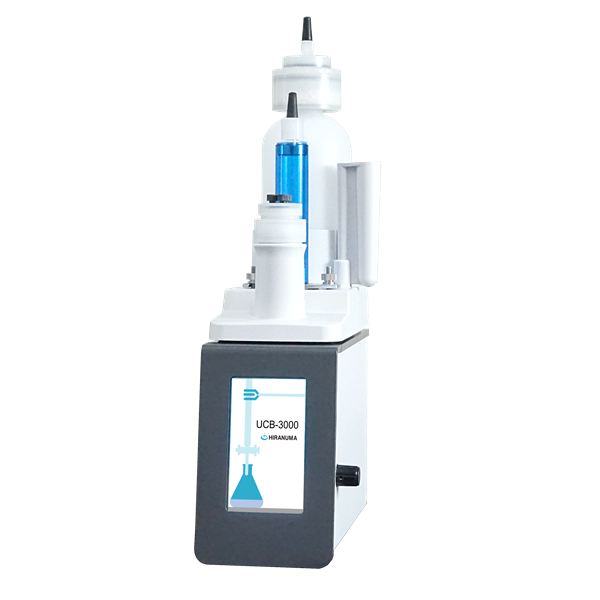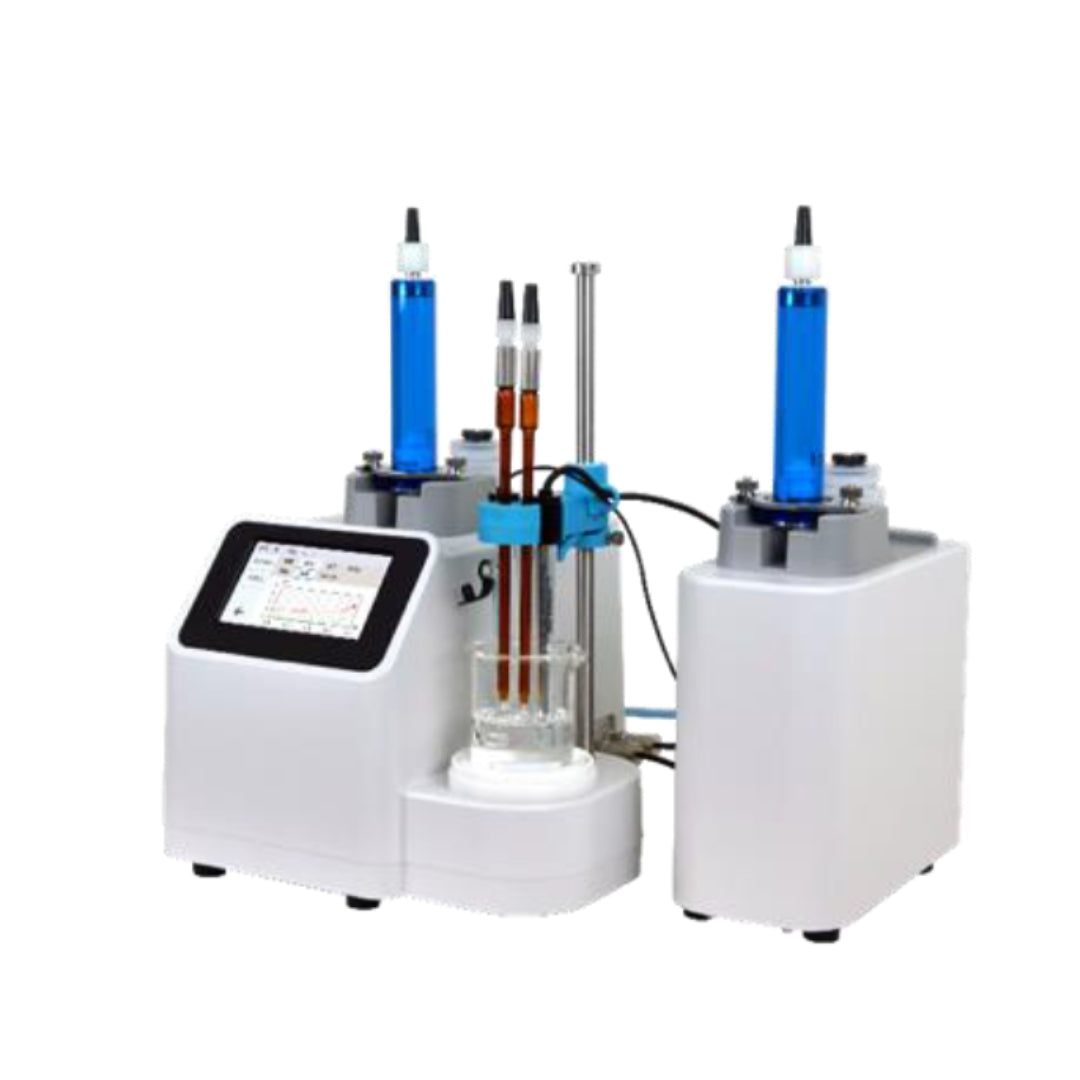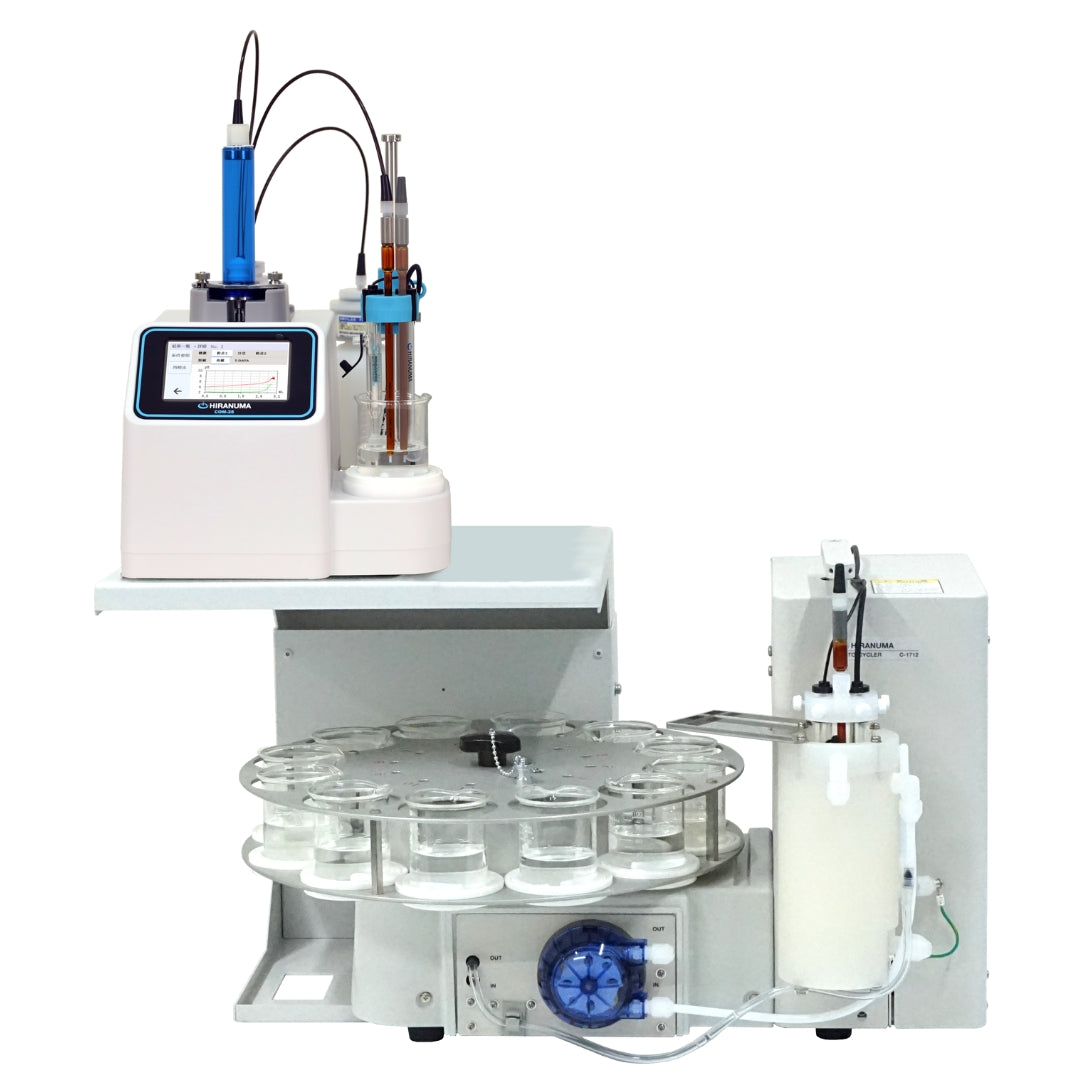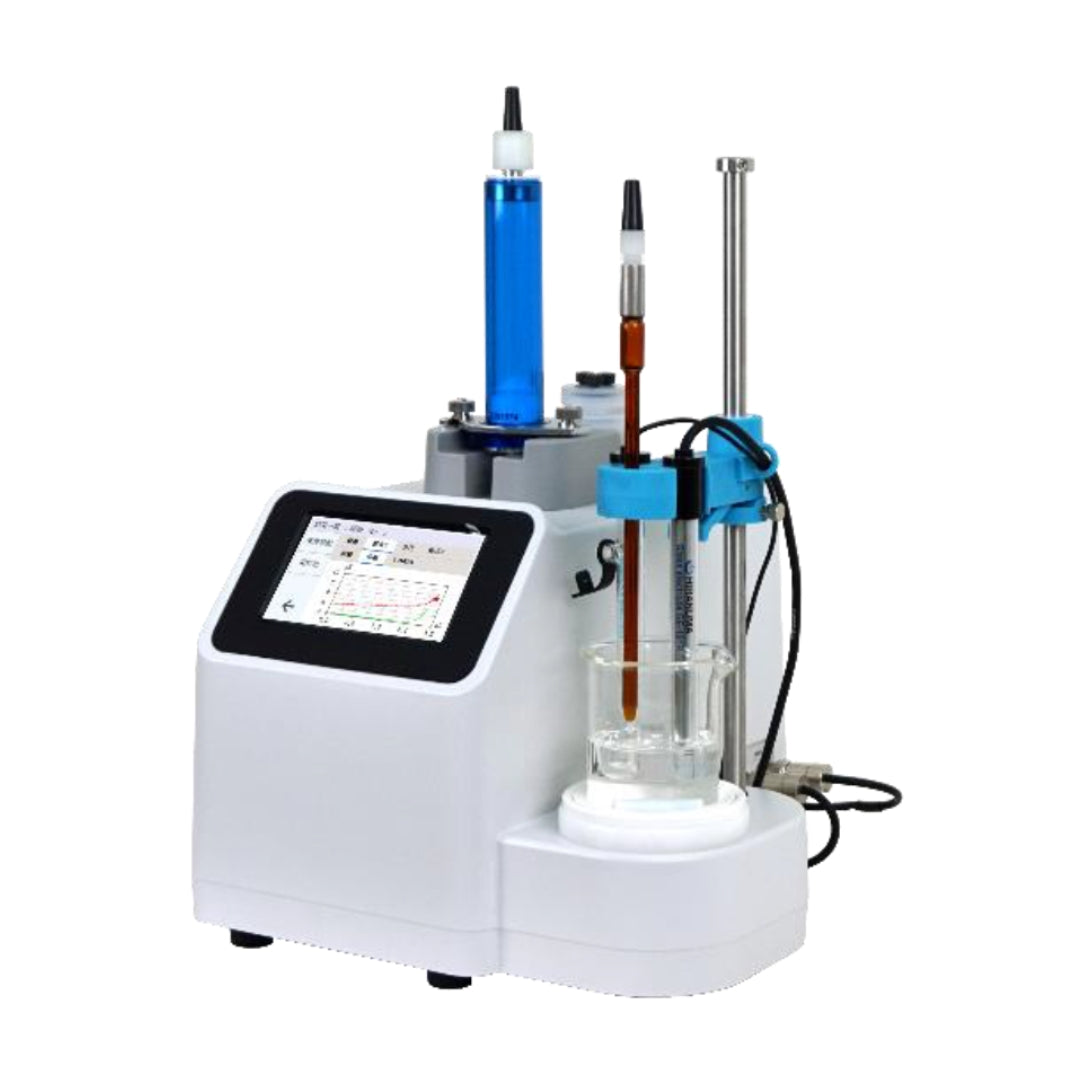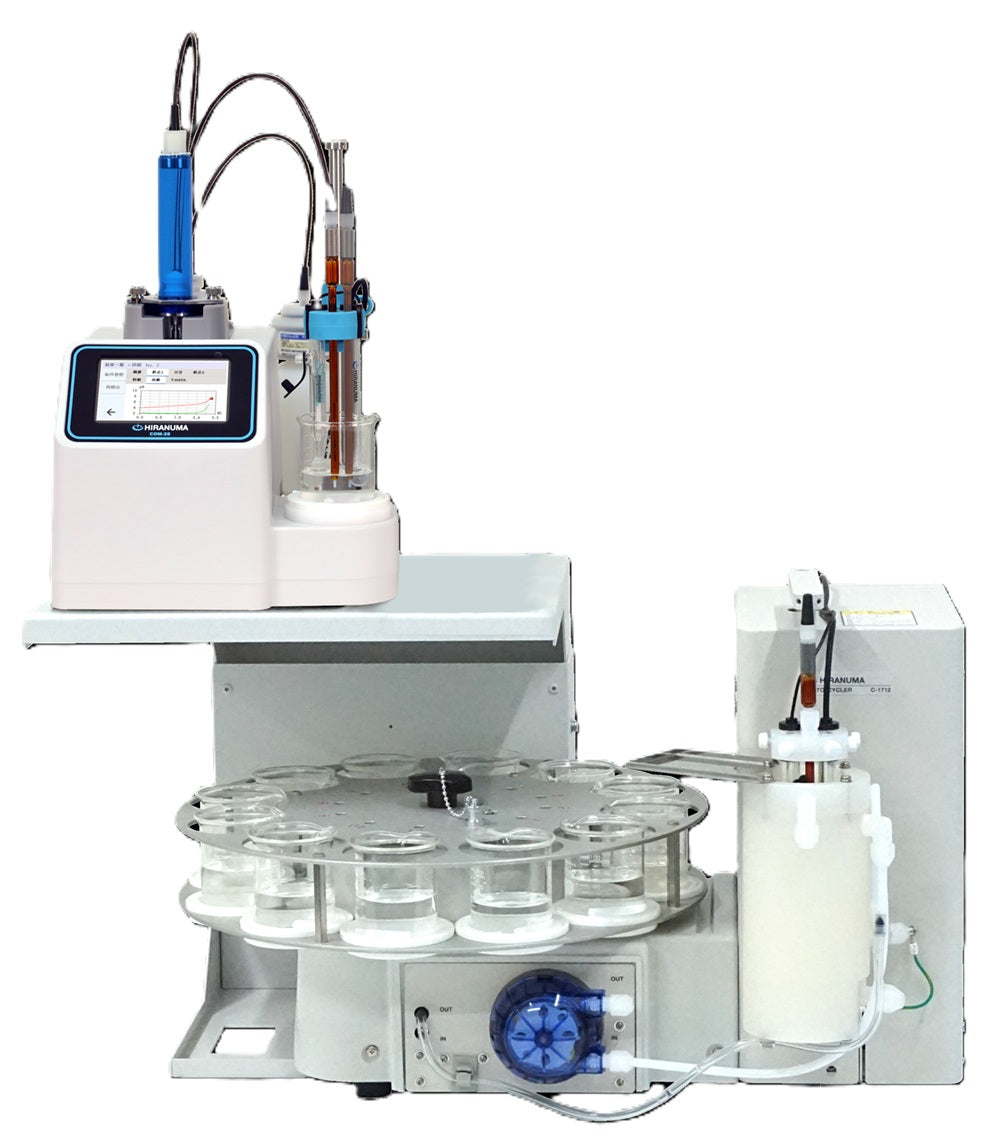| HIRANUMA APPLICATION DATA | Automatic Titrator | Data No. | J2 | Apr. 5,2019 |
| Inorganic acids & Mixed acids | Purity determination of phosphoric acid |
1. Abstract
Phosphoric acid is important reagent as a raw material of chemical industrial reagents and fertilizers. Its production amount is large and it is used in a broad range of fields. The determination method of phosphoric acid purity is described in “JIS (Japanese Industrial Standards) K9005:2006 Phosphoric acid (reagent)”; the purity of phosphoric acid is determined by potentiometric titration with sodium hydroxide standard solution. This report introduces an example of the purity determination of phosphoric acid by this method.
Phosphoric acid reacts with sodium hydroxide as described in the reaction formula (1) ~ (3) because phosphoric acid is triacid. The titration curve of neutralization titration for phosphoric acid theoretically has three inflection points, but practically it shows two inflection points. This is because third acid dissociation constant (pKa) of phosphoric acid is 12.35, the pH at the third inflection point is undetectable value by the titration with strongly basic titrant. The purity of phosphoric acid is determined by the titration to the second inflection point in this measurement.
| H₃PO₄ + NaOH → NaH₂PO₄ + H₂O | ・・・(1) |
| NaH₂PO₄ + NaOH → Na₂HPO₄ + H₂O | ・・・(2) |
| Na₂HPO₄ + NaOH → Na₃HPO₄ + H₂O | ・・・(3) |
2. Configuration of instruments and Reagents
| (1) | Configuration of instruments | ||
| Main unit | : | Hiranuma Automatic Titrator COM series | |
| Electrodes | : | Glass electrode GE-101B Reference electrode RE-201Z *Instead of above electrode, the following electrodes are usable. ・Glass reference combination electrode GR-501BZ…Fixed sleeve type ・Glass reference combination electrode GR-511BZ…Moveable sleeve type |
|
| (2) | Reagents | ||
| Titrant | : | 1 mol/L Sodium hydroxide standard solution | |
3. Measurement procedure
| (1) | Take about 1.5 g of sample into a 100 mL beaker and weigh accurately. |
| (2) | Add 40 mL of DI water without carbon dioxide. |
| (3) | Immerse electrodes and start titration with 1 mol/L sodium hydroxide standard solution. Perform the blank test with the same procedure of sample measurement. |
4. Measurement conditions and results
Examples of titration conditions
Measurement of blank
| Cndt No | 1 | |
| Method | Auto | |
| Buret No. | 1 | |
| Amp No. | 1 | |
| D. Unit | pH | |
| S-Timer | 10 | sec |
| C.P. mL | 0 | mL |
| T Timer | 0 | sec |
| D.P. mL | 0 | mL |
| End Sens | 250 | |
| Over mL | 0.1 | mL |
| Max Vol. | 1 | mL |
| Constant No. | 1 | |
| Size | 0 | mL |
| Blank | 0 | mL |
| Molarity | 1 | mol/L |
| Factor | 1.005 | |
| K | 0 | |
| L | 0 | |
| Unit | mL | |
| Formula | D | |
| Decimal Places | 3 | |
|
Auto In Pram.
|
None | |
| Mode No. | 14 | |
| Pre Int | 0 | sec |
| Del K | 0 | |
| Del Sens | 0 | mV |
| Int Time | 5 | sec |
| Int Sens | 3 | mV |
| Brt Speed | 2 | |
| Pulse | 8 |
Measurement of sample
| Cndt No | 2 | |
| Method | Auto | |
| Buret No. | 1 | |
| Amp No. | 1 | |
| D. Unit | pH | |
| S-Timer | 10 | sec |
| C.P. mL | 0 | mL |
| T Timer | 0 | sec |
| D.P. mL | 20 | mL |
| End Sens | 250 | |
| Over mL | 0.2 | mL |
| Max Vol. | 40 | mL |
| Constant No. | 2 | |
| Size | 0 | g |
| Blank | 0.015 | mL |
| Molarity | 1 | mol/L |
| Factor | 1.005 | |
| K | 49 | * |
| L | 0 | |
| Unit | % | |
| Formula | (D-B)*K*F*M/(S*10) | |
| Decimal Places | 3 | |
|
Auto In Pram.
|
None | |
| Mode No. | 4 | |
| Pre Int | 0 | sec |
| Del K | 9 | |
| Del Sens | 0 | mV |
| Int Time | 3 | sec |
| Int Sens | 3 | mV |
| Brt Speed | 2 | |
| Pulse | 40 | |
*”49 (Parameter K)” comes from “98 (H3PO4)/2” because titrant volume will be twice according to reaction (1) and (2).
Measurement results
Measurement results of blank
| Number of measurement |
Size (g) |
Titrant Volume(mL) |
|---|---|---|
| 1 | – | 0.015 |
| 2 | – | 0.015 |
| Avg.(Blank) | 0.015 mL | |
Measurement results of sample
| Number of measurement |
Size (g) |
Titrant volume (mL) |
Concentration (%) |
|---|---|---|---|
| 1 | 1.6693 | 29.094 | 85.784 |
| 2 | 1.6743 | 29.142 | 85.669 |
| 3 | 1.6797 | 29.277 | 85.790 |
| Statistic calculation |
Average | 85.75 % | |
| SD | 0.07 % | ||
| RSD | 0.08 % | ||
Examples of titration curves
 |
 |
| Measurement of blank | Measurement of sample |
5. Note
(1) Collection of sample
The sample should be collected directly to 100 mL beaker and weighed accurately. The accuracy of sample collection influences the measurement accuracy. Please note that the sample should be carefully taken and accurately weighed.
(2) Control of titrant
The concentrated sodium hydroxide standard solution is used as titrant in this report. The carbon dioxide gas absorber (soda lime) on reagent bottle has to be regularly exchanged because sodium hydroxide readily absorbs carbon dioxide gas in the air (formula (4)).
| 2NaOH + CO₂ → Na₂CO₃ + H₂O | ・・・(4) |
(3) Endpoint detection and calculation of concentration
The titration curve with strong base (sodium hydroxide) shows two inflection points as described in the abstract. The first inflection point at around pH 4 is not detected (“D.P. mL” is set to “20 mL”) and the second inflection point is detected as endpoint. The titrant volume at second inflection point is used for the calculation of concentration.
(4) Reduction of measurement time
The titrant volume was 25 mL or more, the measurement time was about 8.5 min on this measurement. The sodium hydroxide standard solution can be added continuously up to 20 mL by the function “C.P. mL”, it reduces the measurement time. The measurement time was about 4.5 min when using the function “C.P. mL”.
Keywords: Phosphoric acid Neutralization titration , Purity
*Some measurement would not be possible depending on optional configuration of system.


